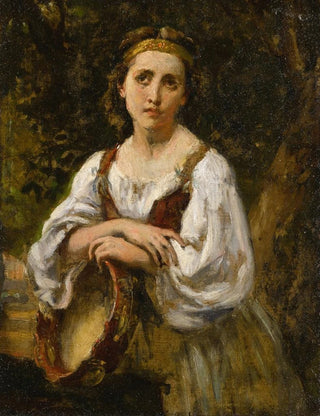Art print | Bohemian girl with drum - Narcisse Virgile Diaz de la Peña


View from behind

Frame (optional)
In the enchanting world of 19th-century art, the art print "Bohémienne au tambour" by Narcisse Virgile Diaz de la Peña stands out for its ability to capture the very essence of bohemian life. This painting, imbued with light and color, evokes a world where music and dance blend with nature, creating an atmosphere that is both nostalgic and vibrant. The central figure, this bohémienne with a drum, seems to invite the viewer on a sensory journey, an immersion into a universe where time stands still and emotions take precedence over reason. The art print of this iconic work allows for rediscovering the magic of Diaz de la Peña's art, while offering a window into a richly creative era.
Style and uniqueness of the work
Narcisse Virgile Diaz de la Peña's style is characterized by early impressionism, where light plays a fundamental role in the composition. In "Bohémienne au tambour," the artist uses delicate brushstrokes and a palette of warm colors to evoke the warmth of a sunny day. The meticulous details of the bohémienne's dress, as well as the reflections of light on her skin, demonstrate remarkable technical mastery. The background, composed of lush landscapes, adds depth to the scene, reinforcing the idea of harmony between man and nature. This work is not only a portrait but also a celebration of bohemian culture, of its freedom and indomitable spirit.
The artist and his influence
Narcisse Virgile Diaz de la Peña, a major figure of the Romantic movement in France, managed to establish himself through his unique style and his ability to translate deep emotions through his canvases. Born in 1807, he was influenced by artists such as Camille Corot and Eugène Delacroix, but developed a distinctive voice that sets him apart in the artistic landscape of his time. His approach to color and light paved the way for many impressionist artists who followed him. "Bohémienne au tambour" is a perfect example of this influence, as it embodies the themes of

Matte finish

View from behind

Frame (optional)
In the enchanting world of 19th-century art, the art print "Bohémienne au tambour" by Narcisse Virgile Diaz de la Peña stands out for its ability to capture the very essence of bohemian life. This painting, imbued with light and color, evokes a world where music and dance blend with nature, creating an atmosphere that is both nostalgic and vibrant. The central figure, this bohémienne with a drum, seems to invite the viewer on a sensory journey, an immersion into a universe where time stands still and emotions take precedence over reason. The art print of this iconic work allows for rediscovering the magic of Diaz de la Peña's art, while offering a window into a richly creative era.
Style and uniqueness of the work
Narcisse Virgile Diaz de la Peña's style is characterized by early impressionism, where light plays a fundamental role in the composition. In "Bohémienne au tambour," the artist uses delicate brushstrokes and a palette of warm colors to evoke the warmth of a sunny day. The meticulous details of the bohémienne's dress, as well as the reflections of light on her skin, demonstrate remarkable technical mastery. The background, composed of lush landscapes, adds depth to the scene, reinforcing the idea of harmony between man and nature. This work is not only a portrait but also a celebration of bohemian culture, of its freedom and indomitable spirit.
The artist and his influence
Narcisse Virgile Diaz de la Peña, a major figure of the Romantic movement in France, managed to establish himself through his unique style and his ability to translate deep emotions through his canvases. Born in 1807, he was influenced by artists such as Camille Corot and Eugène Delacroix, but developed a distinctive voice that sets him apart in the artistic landscape of his time. His approach to color and light paved the way for many impressionist artists who followed him. "Bohémienne au tambour" is a perfect example of this influence, as it embodies the themes of






